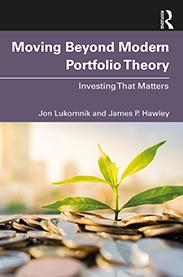(Note: Jon Lukomnik is a senior fellow of High Meadows Institute. This article is the last of three blogs adapted from their new book, Moving Beyond Modern Portfolio Theory: Investing That Matters, to be published in April.)
Everyone has an opinion about short-termism. It has been blamed for underinvestment in infrastructure, basic science, human capital, and research and development. As the CFA Institute, the professional body for portfolio managers and analysts notes: “Short-termism refers to an excessive focus on short-term results at the expense of long-term interests…Corporations too often respond to these pressures by reducing their expenditures on research and development and/or foregoing investment opportunities with positive long-term potential. These decisions can weigh against companies’ development of sustainable products or investment in measures that deliver operational efficiencies, develop their human capital, or effectively manage the social and environmental risks to their business.”
Andy Haldane, the Chief Economist for the Bank of England, puts a quantitative spin on short-termism. He notes that “cash-flows 5 years ahead are discounted at rates more appropriate [to] 8 or more years hence; 10 year ahead cash-flows are valued as if 16 or more years ahead; and cash-flows more than 30 years ahead are scarcely valued at all. The long is short.”
As Haldane notes, the problem with such hyper-discounting of future cash flows is that it results “in long-duration projects suffering disproportionately. This might include projects with high build or sunk costs, including infrastructure and high-tech investments. These projects are often felt to yield the highest long-term (private and social) returns and hence offer the biggest boost to future growth…That makes short-termism a public policy issue,” he concludes.
Short-termism is not a new problem. The Aspen Institute put out a policy paper to address it back in 2009, endorsed by such luminaries as Warren Buffet, Bill George, Lou Gerstner, Jr., Jack Bogle, Felix Rohatyn, Ira Millstein and Richard Trumka.
And yet the problem persists. Why?
We maintain that investors and corporate executives – indeed all human beings – are neurologically inclined to hyper-discount the future. Attempts to mitigate short-termism have not appropriately included how to overcome that hereditary bias.
Vanderbilt Professor Owen Jones notes that functional MRIs show a tension between activity in the limbic, which is an ancient portion of our brains, and the prefrontal cortex, a more recently evolved (in evolutionary terms) brain region. “The limbic areas of the brain are typically considered to be evolutionarily old—more emotional if you will, and with less cognitive and analytic capability than areas of the brain that evolved much later,” he explains. “Lower prefrontal cortex activity and greater limbic activity correlates with subjects biasing their choices toward the sooner, smaller reward. All this raises the hypothesis that there is some sort of a tension at work, when one is making time-discounting decisions, between the more analytic regions of the brain and the more emotional regions of the brain.”
Wilson suggests that irrational hyper-discounting may really be what he calls “time-shifted rationalities.” In other words, what may be irrational today might have served a rational function at some evolutionary stage eons ago. “The average lifespan was much shorter than it is today…Secure rights were limited to what you had in your hand (if you were lucky) or to what you could store around your belly through immediate consumption. Trade was risky in the following sense: you’ve got something over which you have dominion, and you’re considering trading it for something else that you might want more, but which you might have a very small chance of actually getting in return for what you relinquish. For this reason, we can hypothesize that, throughout primate history (indeed for the vast bulk of all organisms), natural selection will have favored heritable predispositions to weigh the concrete present somewhat more heavily than the theoretical future….our basic behavioral predispositions are encountering novel environmental features. And the result of that encounter will often lead to some weird outcomes in the modern era.”
In addition to the differences between our evolutionary programming and the realities of the “modern era” Wilson cites, there is another contextual conundrum. Our thinking about temporal discounting is based on our being human, which means we have a finite time on this world. But today, we are often making temporal decisions for eternally-lived entities. CEOs and Boards do so for corporations, and investors do so for pension funds, endowments, and insurance companies. The very-long term focus of those institutions conflicts with the mortality and biological disposition of the human beings making temporal decisions for them.
Wilson argues that we can “cognitively control some of our investment behavior.” But if the tendency to hyper-discount can be overridden with focus and dedication, then why haven’t we?
Think about which conditions cause emotional reactions and which encourage thoughtful analysis. Limited time, multiple confusing choices, stress and limited knowledge result in emotional decisions, in which we revert, at best, to heuristics. Our limbic takes over. These are exactly the conditions CEOs and institutional investors confront daily. It is similar to what Nobel laureate Daniel Kahneman calls System 1 thinking. System 1 thinking gets us through our day-to-day tasks without too much strain. But it’s wed to precedent and inertia.
When faced with new challenges and strategic choices, decision-makers should try to craft an environment featuring time to contemplate, a limited set of choices, a calm environment and the ability to apply detailed knowledge. System 2 thinking requires us to slow down. That’s not always possible, but it should be the goal. Techniques such as written options memoranda that explicitly discuss what the choices are, the pros and cons of each, the discount rates applied, and time to breakeven slows down the process to allow cognition.
Yes, we are more evolved than our ancestral selves. But we need to create the conditions that allow us to use that evolution so as to solve the issues of today.
Jon Lukomnik and James P. Hawley’s book, Moving Beyond Modern Portfolio Theory: Investing That Matters, is now available for pre-order here.

